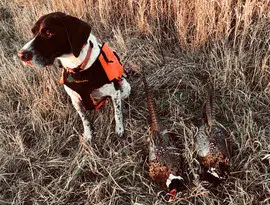
Pheasant numbers jump up in southwestern Minnesota
Outside southwest and west central areas, other areas in pheasant range see declines
Southwest region pheasant numbers saw significant, triple-digit increases in the Minnesota Department of Natural Resources’ annual roadside pheasant survey.
“Pheasant hunters certainly have reason to cheer in the southwest region this year and we also saw increases in the west central portions of the state,” said Tim Lyons, Minnesota DNR upland game research scientist. “Other regions saw declines in pheasant numbers, possibly because of more severe winter weather, and more severe drought during breeding season.”
The pheasant index increased 101% in the southwest region and 38% in the west central region. Other areas saw decreases in pheasant numbers, with numbers dropping 39% in the central, 63% in the east central, 11% in the south central and 50% in the southeast regions.
Statewide, pheasants averaged a 10% increase from 2022 and 26% above the 10-year average. This year’s statewide pheasant index was 53 birds per 100 miles of roads driven, compared to 48 in 2022.
Weather and habitat are the main influences on Minnesota’s pheasant population trends. Weather causes annual fluctuations in pheasant numbers, while habitat drives long-term population trends. Shifts this year are due to weather conditions, with pheasant populations benefiting from favorable weather conditions in the southwest and west central areas. Long term, there is nothing to suggest that some areas’ increase in pheasant numbers will continue as a trend, given that there is not a corresponding increase in habitat.
The Minnesota pheasant hunting season opens 9 a.m. Saturday, Oct. 14.
Partridge numbers increase
Gray (Hungarian) partridge is a less frequently encountered game bird, and partridge numbers increased in this year’s roadside survey. Partridge numbers ticked up in the southwest region, from 2.7 in 2022 to 7.6 birds per 100 miles driven in 2023. The northwest saw the largest boom, with an increase from 2.2 to 14.9 birds per 100 miles driven.
“While some of the increase in partridge numbers could be due to expected, year-to-year fluctuations in the survey, we are hearing from area offices that they’re also seeing more partridge in those areas than they have recent memory,” Lyons said. “Hunters could have some excellent partridge hunting opportunities this season.”
Habitat factors
Conservation Reserve Program acres play a large role in providing habitat for pheasants in Minnesota. The program, authorized under the federal Farm Bill, pays farmers to remove environmentally sensitive land from agricultural production and restore vegetation that will reduce soil erosion, improve water quality, and provide habitat for wildlife and pollinators.
The long-term downward trend in CRP enrollment persisted in 2023, with a loss of 18,000 acres in the pheasant range. The impact of the lost CRP acreage was somewhat mitigated by increases in land enrolled in easement programs like the Conservation Reserve Enhancement Program and Reinvest in Minnesota as well as acquisitions by the U.S. Fish and Wildlife Service and by the Minnesota DNR offset some of the losses of CRP. Overall, there was a net loss of approximately 9,000 acres of protected habitat compared to 2022.
Pheasant hunting areas
Many publicly owned lands are open to hunting, as are private lands enrolled in the state’s Walk-in-Access program (mndnr.gov/walkin). Hunters can use the Minnesota DNR’s online mapping tools to find WMAs by accessing the WMA finder (mndnr.gov/wmas), and the Minnesota DNR Recreation Compass (mndnr.gov/maps/compass) to help locate state hunting grounds and private lands enrolled in the Walk-In Access program, including updates on the condition of specific properties.
Additional resources
The 2023 August Roadside Survey report, a map of pheasant hunting prospects, data for other surveyed species, and information on hunting regulations and bag limits are available on the Minnesota DNR pheasant hunting webpage (mndnr.gov/hunting/pheasant).




Comments